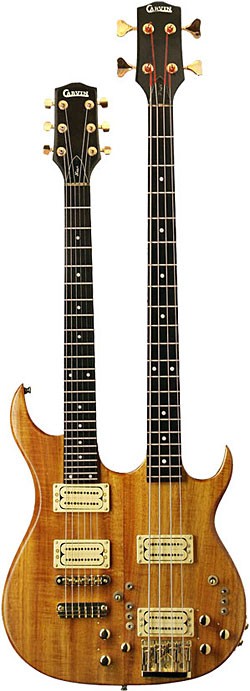

Doubleneck instruments have always been a unique niche in the guitar market, for good reason. They’ve also carried an air of superiority or the insinuation that they were intended for pro players; i.e., those who could deftly switch from one instrument to another in the middle of a song without doffing their part. And though they look hyper-cool strapped on, doing so quickly reveals them to be excruciatingly heavy and cumbersome.
In business for almost 60 years, the Carvin company has been quite successful in its “factory direct” approach. Founded by Lowell Kiesel in Southern California in 1946, Carvin has expanded its facilities and relocated more than once. It now builds guitars, basses, amplifiers, and sound reinforcement gear under one gigantic roof in San Diego. And while the company has several retail stores, the bulk of its business is still done direct via phone, mail, and the internet, and those who order a Carvin stringed instrument have a plethora of options.
Carvin’s DN640 is a unique example in the doubleneck genre. Unlike production doublenecks from other manufacturers (like Gibson’s EBS-1250 and Rickenbacker’s 4080), the bass neck is on the bottom instead of the top. Introduced in 1980, the DN640 and DN612 were the first modern/U.S.-made Carvin doublenecks, although the company had been assembling instruments with such a configuration at its factory since the mid 1950s. Moreover, this “reverse-neck” layout was only one of several unique facets of the DN640.
Carvin instruments are custom-order (except for store stock), but in the early ’80s, the list of options was much shorter than it is today. The original owner of this doubleneck had it made with Hawaiian Koa wood – thus the K designation in the model number. In more recent times, Koa has gained respect as a tone wood, and has accordingly increased in price. The instrument has ebony fretboards and set-neck construction (in ’88, Carvin went to neck-through on doublenecks). The guitar neck has a 24 3/4″ scale, a la Gibson, while the bass neck’s scale is the standard 34″. Each neck has a brass nut, which was in vogue in the early ’80s. The owner also opted for gold hardware – tuners, bridges, and tailpiece, all by Schaller. The only other option Carvin offered at the time were block fretboard inlays. Finish choices at the time were also limited – white, black, red, or natural.
The pickups are Carvin’s own 11-polepiece humbuckers – M22s on the guitar, M22Bs on the bass. The edge-to-edge polepiece design helped prevent signal loss during string bending.
Logic also permeates the layout of the controls. Each neck has a volume control for each pickup, a master tone, and a three-way pickup toggle. Each line of three mini-toggles consists of coil-tap switches for each pickup and a phase switch.
The mini-toggle in the middle of the body (near the pickup selector) is the neck selector. Some later Carvin doublenecks reportedly had the neck selector on the lower control area.
The two output jacks are wired for separate necks, allowing separate amplification for guitar (lower jack) and bass (upper jack). However, both necks can be run through just the lower jack.
Another potential plus for the DN640 was that its body was somewhat smaller than competing doublenecks, inferring less bulkiness. And the original owner of this example said the bass neck’s lower position gave it better balance than a Rick 4080.
Other Carvin doublenecks include two-bass-neck examples (one fretted, one fretless), bass/guitar doublenecks with the bass on top, and two-fers with a Kahler bass vibrato and Floyd Rose guitar vibrato. There was even one left-handed six-string bass/six-string guitar.
Carvin officially discontinued production of doublenecks in 1993.
And of course, Carvin built other doublenecks that didn’t have a bass neck, but the DN640K was a unique and underrated example of twin-neck instruments built by American manufacturers.
Photo: Kevin Wright. Instrument courtesy of carvinmuseum.com.
This article originally appeared in VG‘s March ’05 issue. All copyrights are by the author and Vintage Guitar magazine. Unauthorized replication or use is strictly prohibited.


